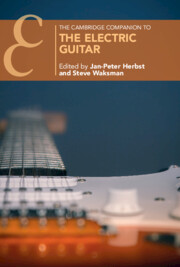Book contents
- The Cambridge Companion to the Electric Guitar
- Cambridge Companions to Music
- The Cambridge Companion to the Electric Guitar
- Copyright page
- Contents
- Figures
- Tables
- Contributors
- 1 Introduction
- Part I History
- Part II Technology and Timbre
- Part III Musical Style and Technique
- Part IV The Electric Guitar in Society
- Personal Take IV: Pamela Cole
- 12 Trailblazers, Self-Creators, and Provers: Celebrating Women in Electric Guitar
- 13 Black Women: Race, Gender, Genre, and the Electric Guitar
- 14 Ecological Entanglements: Following the Electric Guitar from Factory to Forest
- 15 Electro-Collectives: Virtual Guitar Communities
- Part V The Global Instrument
- Index
- References
15 - Electro-Collectives: Virtual Guitar Communities
from Part IV - The Electric Guitar in Society
Published online by Cambridge University Press: 08 November 2024
- The Cambridge Companion to the Electric Guitar
- Cambridge Companions to Music
- The Cambridge Companion to the Electric Guitar
- Copyright page
- Contents
- Figures
- Tables
- Contributors
- 1 Introduction
- Part I History
- Part II Technology and Timbre
- Part III Musical Style and Technique
- Part IV The Electric Guitar in Society
- Personal Take IV: Pamela Cole
- 12 Trailblazers, Self-Creators, and Provers: Celebrating Women in Electric Guitar
- 13 Black Women: Race, Gender, Genre, and the Electric Guitar
- 14 Ecological Entanglements: Following the Electric Guitar from Factory to Forest
- 15 Electro-Collectives: Virtual Guitar Communities
- Part V The Global Instrument
- Index
- References
Summary
Communities of guitarists have existed and evolved in parallel with the instrument’s long and varied historical development. Technological progress in the twentieth century saw two major milestones for the guitar: the invention of the electric guitar, and the birth of the internet. This chapter explores the shift of guitar-based communities to virtual spaces starting with email groups, internet forums, and chat rooms. These communities serve similar functions as real-world communities by sharing knowledge and resources as well as providing spaces for discussions and performances. Peer-to-peer file sharing regenerated an old form of guitar-specific written notation: tablature. Then along came social media, which changed the entire music industry, including online guitar communities. Many of the world’s largest and most visited websites, Facebook, YouTube, X, and Instagram, are havens for guitar communities no longer defined by geographical boundaries. This has had enormous consequences as cultural and aesthetic expressions, particularly in the form of guitar performance practices, are now freely transmitted globally and instantaneously via virtual networks.
Keywords
- Type
- Chapter
- Information
- The Cambridge Companion to the Electric Guitar , pp. 263 - 284Publisher: Cambridge University PressPrint publication year: 2024

